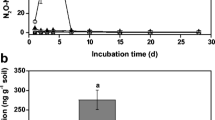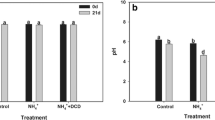Abstract
Inhibitory experiments were conducted to investigate the responses of the population sizes of ammonia-oxidizing archaea (AOA) and bacteria (AOB) and the potential nitrification rates (PNRs) to Cu contamination in four Chinese soils. PNR was determined using a substrate-induced nitrification (SIN) assay, and the population size of the nitrifiers represented by amoA gene abundances was quantified using a real-time polymerase chain reaction (qPCR) assay. Both population size and PNR of the ammonia oxidizers reduced considerably at high Cu concentrations in all the soils. Bacterial amoA gene abundance was reduced by from 107-fold (Hailun soil) to more than 232-fold (Hangzhou soil) at the highest Cu concentrations (2,400 mg kg−1 Cu for Hailun, Langfang and Guangzhou soils and 1,600 mg kg−1 Cu for Hangzhou soil), while reduction in archaeal amoA gene abundance was from 10-fold (Langfang soil) to 89-fold (Hangzhou soil). AOA seemed more tolerant to Cu contamination than AOB. Nitrification rates were inhibited by more than 50% at a Cu concentration of 600 mg kg−1, and by more than 90% at the highest Cu concentrations in all soils. These results indicated that both AOA and AOB can be inhibited by toxic metals, highlighting the need to consider the role of AOA in nitrification in soils.


Similar content being viewed by others
References
Altmann D, Stief P, Amann R, de Beer D, Schramm A (2003) In situ distribution and activity of nitrifying bacteria in freshwater sediment. Environ Microbiol 5:798–803
Arp D, Sayavedra-Soto L, Hommes N (2002) Molecular biology and biochemistry of ammonia oxidation by Nitrosomonas europaea. Arch Microbiol 178:250–255. doi:10.1007/s00203-002-0452-0
Arp DJ, Bottomley PJ (2006) Nitrifiers: more than 100 years from isolation to genome sequences. Microbe 1:229–234
Bakken LR (1997) In Modern Soil Microbiology. Eds. J van Elsas, D Trevors and E Wellington. pp 47–61, Marcel Dekker, New York
Balaban NQ, Merrin J, Chait R, Kowalik L, Leibler S (2004) Bacterial persistence as a phenotypic switch. Science 305:1622–1625. doi:10.1126/science.1099390
Belser LW, Schmidt EL (1978) Serological diversity within a terrestrial ammonia-oxidizing population. Appl Environ Microbiol 36:589–593
Broos K, Mertens J, Smolders E (2005) Toxicity of heavy metals in soil assessed with various soil microbial and plant growth assays: As comparative study. Environ Toxicol Chem 24:634–640. doi:10.1897/04-036R.1
Cavagnaro T, Jackson L, Scow K, Hristova K (2007) Effects of arbuscular mycorrhizas on ammonia oxidizing bacteria in an organic farm soil. Microb Ecol 54:618–626. doi:10.1007/s00248-007-9212-7
Cavagnaro TR, Jackson LE, Hristova K, Scow KM (2008) Short-term population dynamics of ammonia oxidizing bacteria in an agricultural soil. Appl Soil Ecol. doi:10.1016/j.apsoil.2008.1002.1006
Chabrerie O, Laval K, Puget P, Desaire S, Alard D (2003) Relationship between plant and soil microbial communities along a successional gradient in a chalk grassland in north-western France. Appl Soil Ecol 24:43–56. doi:10.1016/S0929-1393(03) 00062-3
Coskuner G, Ballinger SJ, Davenport RJ (2005) Agreement between theory and measurement in quantification of ammonia-oxidizing bacteria. Appl Environ Microbiol 71:6325–6334
Daims H, Ramsing NB, Schleifer K-H, Wagner M (2001a) Cultivation independent, semiautomatic determination of absolute bacterial cell numbers in environmental samples by fluorescence in situ hybridization. Appl Environ Microbiol 67:5810–5818
Daims H, Purkhold U, Bjerrum L, Arnold E, Wilderer PA, Wagner M (2001b) Nitrification in sequencing biofilm batch reactors: lessons from molecular approaches. Water Sci Technol 43:9–18
Dancer WS, Peterson LA, Chesters G (1973) Ammonification and nitrification of N as influenced by soil pH and previous N treatments. Soil Sci Soc Am J 37:67–69
Doelman P, Haanstra L (1984) Short-term and long-term effects of cadmium, chromium, copper, nickel, lead, and zinc on soil microbial respiration in relation to abiotic soil factors. Plant Soil 79:317–327. doi:10.1007/BF02184325
Fox GE, Magrum LJ, Balch WE, Wolfe RS, Woese CR (1977) Classification of methanogenic bacteria by 16 S ribosomal RNA characterization. Proc Natl Acad Sci USA 74:4537–4541. doi:10.1073/pnas.74.10.4537
Francis CA, Roberts KJ, Beman JM, Santoro AE, Oakley BB (2005) Ubiquity and diversity of ammonia-oxidizing archaea in water columns and sediments of the ocean. Proc Natl Acad Sci USA 102:14683–14688. doi:10.1073/pnas.0506625102
Harms G, Layton AC, Dionisi, HM, Gregory IR, Garrett VM, Hawkins SA, Robinson KG, Sayler GS (2003) Real-time PCR quantification of nitrifying bacteria in a municipal wastewater treatment plant. Environ Sci Technol 37:343–351
He J-Z, Shen J-P, Zhang L-M, Zhu Y-G, Zheng Y-M, Xu M-G, Di H-J (2007) Quantitative analyses of the abundance and composition of ammonia-oxidizing bacteria and ammonia-oxidizing archaea of a Chinese upland red soil under long-term fertilization practices. Environ Microbiol 9:2364–2374. doi:10.1111/j.1462-2920.2007.01358.x
Jackson LE, Burger M, Cavagnaro TR (2008) Roots, nitrogen transformations, and ecosystem services. Annu Rev Plant Biol 59:341–363. doi:10.1146/annurev.arplant.59.032607.092932
Jiang QQ and Bakken LR (1999) Comparison of Nitrosospira strains isolated from terrestrial environments. FEMS Microbiol Ecol 30:171–186
Jordan FL, Cantera JL, Fenn ME, Stein LY (2005) Autotrophic ammonia-oxidizing bacteria contribute minimally to nitrification in a nitrogen-impacted forested ecosystem. Appl Environ Microbiol 71:197–206. doi:10.1128/AEM.71.1.197-206.2005
Könneke M, Bernhard AE, De la Torre JR, Walker CB, Waterbury JB, Stahl DA (2005) Isolation of an autotrophic ammonia-oxidizing marine archaeon. Nature 437:543–546. doi:10.1038/nature03911
Kandle O, König H (1998) Cell wall polymers in Archaea (Archaebacteria). Cell Mol Life Sci 54:305–308. doi:10.1007/s000180050156
Karner MB, DeLong EF, Karl DM (2001) Archaeal dominance in the mesopelagic zone of the Pacific Ocean. Nature 409:507–510. doi:10.1038/35054051
Khan S, Cao Q, Zheng YM, Huang YZ, Zhu YG (2008) Health risks of heavy metals in contaminated soils and food crops irrigated with wastewater in Beijing, China. Environ Pollut 152:686–692. doi:10.1016/j.envpol.2007.06.056
Kindaichi T, Kawano Y, Ito T, Satoh H, Okabe S (2006) Population dynamics and in situ kinetics of nitrifying bacteria in autotrophic nitrifying biofilms as determined by real-time quantitative PCR. Biotechnol Bioeng 94:1111–1121
Kowalchuk GA, Stephen JR (2001) Ammonia-oxidizing bacteria: a model for molecular microbial ecology. Annu Rev Microbiol 55:485–529. doi:10.1146/annurev.micro.55.1.485
Leininger S, Urich T, Schloter M, Schwark L, Qi J, Nicol GW, Prosser JI, Schuster SC, Schleper C (2006) Archaea predominate among ammonia-oxidizing prokaryotes in soils. Nature 442:806–809. doi:10.1038/nature04983
Lydmark P, Almstrand R, Samuelsson K, Mattsson A, Sörensson F, Lindgren P-E, Hermansson M (2007) Effects of environmental conditions on the nitrifying population dynamics in a pilot wastewater treatment plant. Environ Microbiol 9:2220–2233
Ma YB, Lombi E, Oliver IW, Nolan AL, McLaughlin MJ (2006) Long-term aging of copper added to soils. Environ Sci Technol 40:6310–6317. doi:10.1021/es060306r
Marriott EE, Wander MM (2006) Total and labile soil organic matter in organic and conventional farming systems. Soil Sci Soc Am J 70:950–959. doi:10.2136/sssaj2005.0241
Matejovic I (1997) Determination of carbon and nitrogen in samples of various soils by the dry combustion. Commun Soil Sci Plant Anal 28:1499–1511. doi:10.1080/00103629709369892
Nicol GW, Schleper C (2006) Ammonia-oxidising Crenarchaeota: important players in the nitrogen cycle? Trends Microbiol 14:207–212. doi:10.1016/j.tim.2006.03.004
Nies DH (1999) Microbial heavy-metal resistance. Appl Microbiol Biotechnol 51:730–750. doi:10.1007/s002530051457
Nishio T, Fujimoto T (1989) Kinetics of denitrification of various amounts of ammonium added to soils. Soil Biol Biochem 22:51–56. doi:10.1016/0038-0717(90)90059-9
Okano Y, Hristova KR, Leutenegger CM, Jackson LE, Denison RF, Gebreyesus B, Lebauer D, Scow KM (2004) Application of real-time PCR to study effects of ammonium population size of ammonia-oxidizing bacteria in soil. Appl Environ Microbiol 70:1008–1016. doi:10.1128/AEM.70.2.1008-1016.2004
Oorts K, Ghesquiere U, Swinnen K, Smolders E (2006) Soil properties affecting the toxicity of CuCl2 and NiCl2 for soil. Environ Toxicol Chem 25:836–844. doi:10.1897/04-672R.1
Oved T, Shaviv A, Goldrath T, Mandelbaum RT, Minz D (2001) Influence of effluent irrigation on community composition and function of ammonia-oxidizing bacteria in soil. Appl Environ Microbiol 67:3426–3433. doi:10.1128/AEM.67.8.3426-3433.2001
Premi PR, Cornfield AH (1969) Effects of addition of copper, manganese, zinc and chromium compounds on ammonification and nitrification during incubation of soil. Plant Soil 31:345–352. doi:10.1007/BF01373578
Smit E, Leeflang P, Wernars K (1997) Detection of shifts in microbial community structure and diversity in soil caused by Cu contamination using amplified ribosomal DNA restriction analysis. FEMS Microbiol Ecol 23:249–261. doi:10.1111/j.1574-6941.1997.tb00407.x
Smolders E, Brans K, Coppens F, Merckx R (2001) Potential nitrification rate as a tool for screening toxicity in metal-contaminated soils. Environ Toxicol Chem 20:2469–2474 doi:10.1897/1551-5028(2001)020<2469:PNRAAT>2.0.CO;2
Smolders E, Buekers J, Oliver I, McLaughlin MJ (2004) Soil properties affecting toxicity of zinc to soil microbial properties in laboratory-spiked and field-contaminated soils. Environ Toxicol Chem 23:2633–2640. doi:10.1897/04-27
Stephen JR, Chang YJ, Macnaughton SJ, Kowalchuk GA, Leung KT, Flemming CA, White DC (1999) Effect of toxic metals on indigenous soil-subgroup Proteobacterium ammonia oxidizer community structure and protection against toxicity by inoculated metal-resistant bacteria. Appl Environ Microbiol 65:95–101
Stephen JR, Kowalchuk GA, Bruns MAV, McCaig AE, Phillips CJ, Embley TM, Prosser JI (1998) Analysis of beta-subgroup proteobacterial ammonia oxidizer populations in soil by denaturing gradient gel electrophoresis analysis and hierarchical phylogenetic probing. Appl Environ Microbiol 64:2958–2965
Tan KH (2005) Soil sampling, preparation, and analysis. Taylor & Francis Group, Boca Raton, the United States, pp 154–173
Thibault DH, Sheppard MI (1992) A disposable system for soil pore-water extraction by centrifugation. Commun Soil Sci Plant Anal 23:1629–1641. doi:10.1080/00103629209368692
Tourna M, Freitag TE, Nicol GW, Prosser JI (2008) Growth, activity and temperature responses of ammonia-oxidizing archaea and bacteria in soil microcosms. Environ Microbiol 10:1357–1364. doi:10.1111/j.1462-2920.2007.01563.x
Treusch AH, Leininger S, Kletzin A, Schuster SC, Klenk HP, Schleper C (2005) Novel genes for nitrite reductase and Amo-related proteins indicate a role of uncultivated mesophilic crenarchaeota in nitrogen cycling. Environ Microbiol 7:1985–1995. doi:10.1111/j.1462-2920.2005.00906.x
Valentine DL (2007) Adaption to energy stress dictate the ecology and evolution of the archaea. Nat Rev Microbiol 5:316–323. doi:10.1038/nrmicro1619
Woese CR, Kandler O, Wheelis ML (1990) Towards a natural system of organisms: proposal for the domains archaea, bacteria, and eucarya. Proc Natl Acad Sci USA 87:4576–4579. doi:10.1073/pnas.87.12.4576
Wuchter C, Abbas B, Coolen MJL, Herfort L, van Bleijswijk J, Timmers P, Strous M, Teira E, Herndl GJ, Middelburg JJ, Schouten S, Sinninghe Damsté JS (2006) Archaeal nitrification in the ocean. Proc Natl Acad Sci USA 103:12317–12322. doi:10.1073/pnas.0600756103
Xia Y, Zhu YG, Gu Q, He JZ (2007) Does long-term fertilization treatment affct the response of soil ammonia-oxidizing bacterial communities to Zn contamination? Plant Soil 301:245–254. doi:10.1007/s11104-007-9441-z
Zarcinas BA, McLaughlin MJ, Smart MK (1996) The effect of acid digestion technique on the performance of nebulization systems used in inductively coupled plasma spectrometry. Commun Soil Sci Plant Anal 27:1331–1354. doi:10.1080/00103629609369636
Acknowledgements
The authors would like to thank the financial support of the Chinese Academy of Sciences (KZCX1-YW-0603) and the International Copper Association and the Nickel Producers Environmental Research Association. The authors also thank Professors Jim Prosser and Ian J Alexander for critical comments on this paper.
Author information
Authors and Affiliations
Corresponding author
Additional information
Responsible Editor: Petra Marschner.
Rights and permissions
About this article
Cite this article
Li, X., Zhu, YG., Cavagnaro, T.R. et al. Do ammonia-oxidizing archaea respond to soil Cu contamination similarly asammonia-oxidizing bacteria?. Plant Soil 324, 209–217 (2009). https://doi.org/10.1007/s11104-009-9947-7
Received:
Accepted:
Published:
Issue Date:
DOI: https://doi.org/10.1007/s11104-009-9947-7




